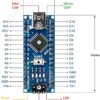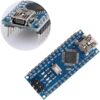+251 99 380 2995 | +251 97 022 2227 | [email protected]






Arduino Nano
Br 1,250.00
- Operating Voltage(logic level): 5V
- 8 analog inputs ports: A0 ~ A7
- 14 Digital input / output ports: TX,RX,D2 ~ D13
- 6 PWM ports: D3, D5, D6, D9, D10, D11
- 1 pairs of TTL level serial transceiver ports RX / TX
- Using Atmel Atmega328P-AU MCU
- Support USB download and Power
- Support for external 5V ~ 12V DC power supply
- Support ISP download
- Arduino Nano is a small, complete, flexible and breadboard-friendly Microcontroller board, based on ATmega328p, developed by Arduino.cc in Italy in 2008 and contains 30 male I/O headers, configured in a DIP30 style.
- Arduino Nano Pinout contains 14 digital pins, 8 analog Pins, 2 Reset Pins & 6 Power Pins.
- It is programmed using Arduino IDE, which can be downloaded from Arduino Official site.
- Arduino Nano is simply a smaller version of Arduino UNO, thus both have almost the same functionalities.
- Arduino Nano’s maximum current rating is 40mA, so the load attached to its pins shouldn’t draw current more than that.
- Each of these Digital & Analog Pins is assigned with multiple functions but their main function is to be configured as Input/Output.
- Arduino Pins are acted as Input Pins when they are interfaced with sensors, but if you are driving some load then we need to use them as an Output Pin.
- Functions like pinMode() and digitalWrite() are used to control the operations of digital pins while analogRead() is used to control analog pins.
- The analog pins come with a total resolution of 10-bits which measures the value from 0 to 5V.
- Arduino Nano comes with a crystal oscillator of frequency 16 MHz. It is used to produce a clock of precise frequency using constant voltage.
- There is one limitation of using Arduino Nano i.e. it doesn’t come with a DC power jack, which means you can not supply an external power source through a battery.
- This board doesn’t use standard USB for connection with a computer, instead, it comes with Type-B Micro USB.
- The tiny size and breadboard-friendly nature make this device an ideal choice for most applications where the size of the electronic components is of great concern.
- Flash memory is 16KB or 32KB that all depends on the Atmega board i.e Atmega168 comes with 16KB of flash memory while Atmega328 comes with a flash memory of 32KB. Flash memory is used for storing code. The 2KB of memory out of total flash memory is used for a bootloader.
- The SRAM memory of 2KB is present in Arduino Nano.
- Arduino Nano has an EEPROM memory of 1KB.
Arduino Nano is a very useful device that comes with a wide range of applications and covers less space as compared to other Arduino boards. Breadboard-friendly nature makes it stand out from other boards. Following are the main applications of Arduino Nano:
- Engineering Students’ Projects.
- Medical Instruments
- Industrial Automation
- Android Applications
- GSM Based Projects
- Embedded Systems
- Automation and Robotics










